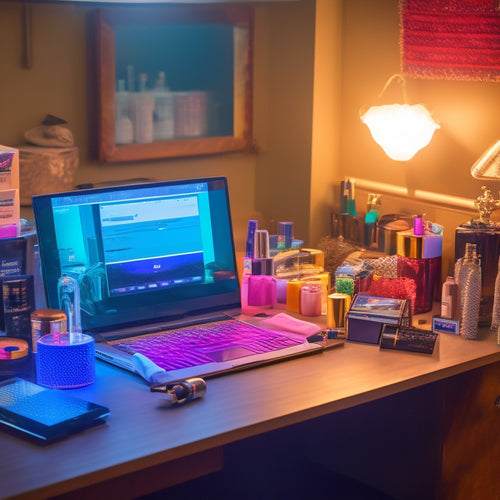
Revolutionizing Dance Education Through Online Platforms
Share
The COVID-19 pandemic has accelerated a permanent shift in dance education, propelling the industry towards a digital revolution. Virtual classrooms have increased student enthusiasm, with satisfaction rates rising from 76% to 85%. Interactive learning experiences have facilitated immersive experiences, overcoming online teaching challenges. As technology evolves, innovative approaches converge with advancements, prioritizing accessibility and inclusivity. Virtual reality integration transports students into new environments, fostering engagement and creativity. As the industry continues to transform, stay ahead of the curve and discover the latest developments shaping the future of dance education.
Key Takeaways
• The COVID-19 pandemic accelerated the shift to online dance education, increasing student enthusiasm and satisfaction rates from 76% to 85%.
• Interactive multimedia content and real-time feedback mechanisms stimulate participation and foster a sense of community in virtual classrooms.
• Innovative approaches in online dance education converge with technological advancements, enabling immersive and engaging learning experiences.
• Virtual and augmented reality integration in online platforms transport students into new dimensions, making dance education more accessible and inclusive.
• The development of cutting-edge tools and platforms prioritizes interactive learning, creativity, and engagement in online dance education.
Embracing the Digital Dance Revolution
As the COVID-19 pandemic accelerated the shift to online learning platforms, dance education has progressively moved to virtual classrooms, fostering a significant surge in student enthusiasm for dance learning, with satisfaction rates soaring from 76% to 85%.
This paradigm shift has enabled dance educators to harness the power of interactive learning, facilitating immersive and engaging virtual experiences. Virtual engagement has become a cornerstone of online dance education, allowing students to connect with instructors and peers in real-time, despite physical distance.
Overcoming Online Teaching Challenges
While online dance education has opened up new avenues for student engagement, it also presents a unique set of challenges that educators must navigate to guarantee effective teaching and learning. Overcoming these challenges requires creative solutions that prioritize improving engagement and enhancing interaction.
Some strategies for overcoming online teaching challenges include:
- Implementing interactive multimedia content to stimulate student participation
- Using real-time feedback mechanisms to foster a sense of community
- Creating virtual breakout rooms for group discussions and collaborations
- Incorporating gamification elements to increase student motivation and enjoyment
Innovating Dance Education for Tomorrow
Embracing the future of dance education, innovative approaches must converge with technological advancements to revolutionize the way we learn, teach, and experience dance.
As we look to the future, interactive learning experiences will become increasingly vital in fostering engagement and creativity in dance students. Virtual reality integration, for instance, can transport students into immersive environments that simulate real-world dance scenarios, allowing them to practice and perfect their craft in a more interactive and engaging way.
By harnessing the power of technology, dance education can evolve to become more accessible, inclusive, and effective.
As we innovate dance education for tomorrow, we must prioritize the development of cutting-edge tools and platforms that cater to the diverse needs of dance students and educators alike.
Frequently Asked Questions
How Do Online Dance Classes Accommodate Students With Disabilities?
Ironically, online dance classes can be more inclusive than traditional studios, offering students with disabilities accessible choreography and inclusive pedagogy, ensuring equal opportunities for all to experience the joy of dance.
Can Online Dance Education Provide Equivalent Certification to In-Person Training?
Online dance education can provide equivalent certification to in-person training by meeting rigorous accreditation standards and employing virtual assessments that simulate real-world dance scenarios, ensuring students receive thorough training and evaluation.
What Is the Ideal Student-To-Instructor Ratio for Online Dance Classes?
When determining the ideal student-to-instructor ratio for online dance classes, consider factors such as virtual feedback, personalized attention, and teacher workload to guarantee effective instruction, with a suggested ratio of 8:1 to facilitate meaningful interactions and optimize learning outcomes.
How Do Online Dance Instructors Ensure Student Accountability and Participation?
To promote student accountability and participation, online dance instructors can leverage virtual motivation techniques, such as gamification and rewards, and provide real-time feedback through video analysis and personalized coaching, fostering a sense of community and encouraging active engagement.
Can Online Dance Education Be Adapted for Cross-Cultural Exchange Programs?
"Online dance education can be adapted for cross-cultural exchange programs by embracing cultural fusion and leveraging global accessibility, fostering a rich tapestry of diverse perspectives and artistic expression."
Related Posts
-

Group Dance Makeup Tutorials for Online Success
As you immerse yourself in the world of group dance makeup tutorials, you'll need to master essential makeup techniqu...
-

Why Dance Makeup Artists Need Online Solutions
As a dance makeup artist, you're likely struggling to attract clients and grow your business due to poor online visib...

